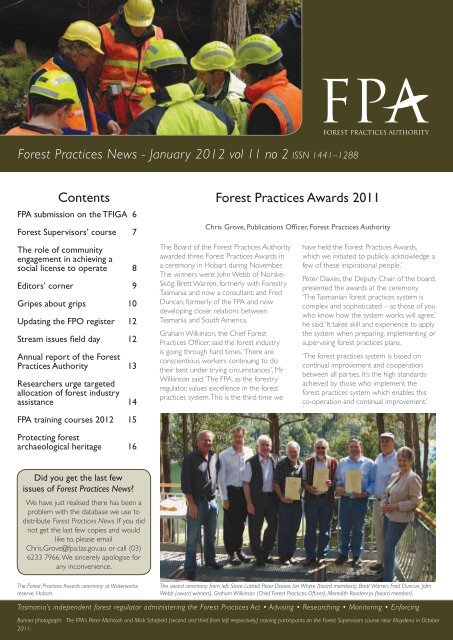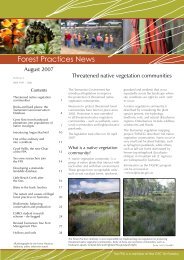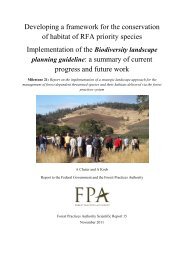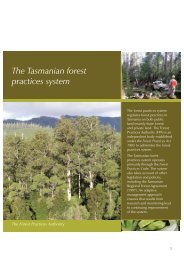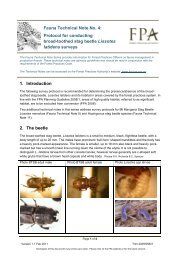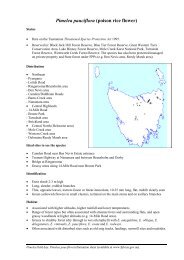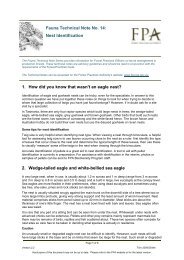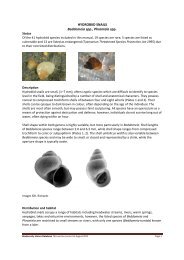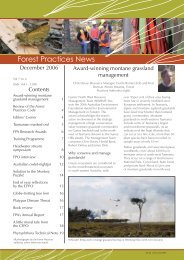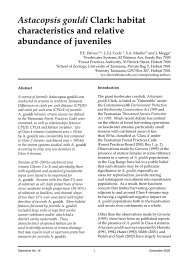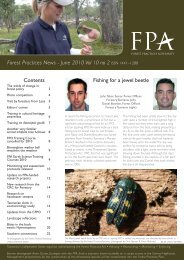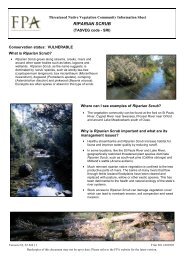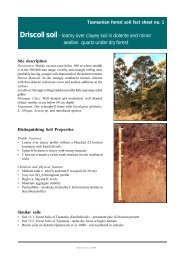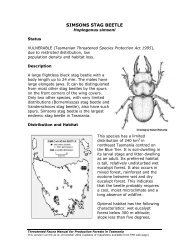FPN vol 11 no 2 January 2012 - The Forest Practices Authority
FPN vol 11 no 2 January 2012 - The Forest Practices Authority
FPN vol 11 no 2 January 2012 - The Forest Practices Authority
You also want an ePaper? Increase the reach of your titles
YUMPU automatically turns print PDFs into web optimized ePapers that Google loves.
<strong>Forest</strong> <strong>Practices</strong> News - <strong>January</strong> <strong>2012</strong> <strong>vol</strong> <strong>11</strong> <strong>no</strong> 2 ISSN 1441–1288ContentsFPA submission on the TFIGA 6<strong>Forest</strong> Supervisors’ course 7<strong>The</strong> role of communityengagement in achieving asocial license to operate 8Editors’ corner 9Gripes about grips 10Updating the FPO register 12Stream issues field day 12Annual report of the <strong>Forest</strong><strong>Practices</strong> <strong>Authority</strong> 13Researchers urge targetedallocation of forest industryassistance 14<strong>Forest</strong> <strong>Practices</strong> Awards 20<strong>11</strong>Chris Grove, Publications Officer, <strong>Forest</strong> <strong>Practices</strong> <strong>Authority</strong><strong>The</strong> Board of the <strong>Forest</strong> <strong>Practices</strong> <strong>Authority</strong>awarded three <strong>Forest</strong> <strong>Practices</strong> Awards ina ceremony in Hobart during November.<strong>The</strong> winners were: John Webb of Norske-Skög; Brett Warren, formerly with <strong>Forest</strong>ryTasmania and <strong>no</strong>w a consultant; and FredDuncan, formerly of the FPA and <strong>no</strong>wdeveloping closer relations betweenTasmania and South America.Graham Wilkinson, the Chief <strong>Forest</strong><strong>Practices</strong> Officer, said the forest industryis going through hard times. ‘<strong>The</strong>re areconscientious workers continuing to dotheir best under trying circumstances', MrWilkinson said. ‘<strong>The</strong> FPA, as the forestryregulator, values excellence in the forestpractices system. This is the third time wehave held the <strong>Forest</strong> <strong>Practices</strong> Awards,which we initiated to publicly ack<strong>no</strong>wledge afew of these inspirational people.’Peter Davies, the Deputy Chair of the board,presented the awards at the ceremony‘<strong>The</strong> Tasmanian forest practices system iscomplex and sophisticated – as those of youwho k<strong>no</strong>w how the system works will agree,’he said. ‘It takes skill and experience to applythe system when preparing, implementing orsupervising forest practices plans.‘<strong>The</strong> forest practices system is based oncontinual improvement and cooperationbetween all parties. It’s the high standardsachieved by those who implement theforest practices system which enables thisco-operation and continual improvement.’FPA training courses <strong>2012</strong> 15Protecting forestarchaeological heritage 16Did you get the last fewissues of <strong>Forest</strong> <strong>Practices</strong> News?We have just realised there has been aproblem with the database we use todistribute <strong>Forest</strong> <strong>Practices</strong> News. If you did<strong>no</strong>t get the last few copies and wouldlike to, please emailChris.Grove@fpa.tas.gov.au or call (03)6233 7966. We sincerely apologise forany inconvenience.<strong>The</strong> <strong>Forest</strong> <strong>Practices</strong> Awards ceremony at Waterworksreserve, Hobart.<strong>The</strong> award ceremony: from left, Steve Luttrell, Peter Davies, Ian Whyte (board members), Brett Warren, Fred Duncan, JohnWebb (award winners), Graham Wilkinson (Chief <strong>Forest</strong> <strong>Practices</strong> Officer), Meredith Roodenrys (board member).Tasmania’s independent forest regulator administering the <strong>Forest</strong> <strong>Practices</strong> Act • Advising • Researching • Monitoring • EnforcingBanner photograph: <strong>The</strong> FPA’s Peter McIntosh and Mick Schofield (second and third from left respectively) training participants on the <strong>Forest</strong> Supervisors course near Maydena in October20<strong>11</strong>.
<strong>Forest</strong> <strong>Practices</strong> Awards 20<strong>11</strong>John WebbExcellence in forest practices planpreparationThis award is judged on the basis ofconsistency, clarity, high quality, freedomfrom errors and in<strong>no</strong>vation or excellence indealing with complex or challenging issuesfor one or more forest practices plans.John’s planning work over several years hasbeen consistently characterised by attentionto detail and discussion with colleagues,consultants and FPA staff in order to achievegood outcomes. During the past year Johnhas produced several forest practices plansthat have required significant considerationand planning for the protection ofnatural values in pine plantation coupesin the Maydena area, which is one of themore complex regions of Tasmania forgeomorphic land management. Many of theplantations were established in the 1970sand 80s before the <strong>Forest</strong> <strong>Practices</strong> Code waspublished, with <strong>no</strong> reserves around streamsand sinkholes. Consequently, harvestingreforestation have required very carefulplanning. John has worked closely withthe FPA Earth Sciences Program, Norske-Skög contractors and out-of-industrystakeholders to achieve good managementoutcomes.John was <strong>no</strong>minated by Peter McIntoshand Adrian Slee of the FPA and SandraHetherington of Norske-Skög. <strong>The</strong>ir<strong>no</strong>minations said of him:John tends to focus on the more difficultFPPs for Norske-Skög because he has a goodJohn with the results of his planning. (photo by Norske-Skög)operational background and solid experience.With more than 20 years experience inNorske-Skög forests John understands theestate and the potential issues very well. Heis meticulous with his field work planning andsets very high standards for himself and thecompany in his FPP preparation.John produces very good maps that operatorscan follow well. This often takes a lot of extratime to get details correct, but it is the bestway of communicating some of our specialissues.John's plans have scored very well in FPAaudits.John’s interview with <strong>Forest</strong><strong>Practices</strong> NewsHow did you start working in forestry?I started working with Australian NewsprintMills 27 years ago. <strong>The</strong> company haschanged owners three times since that timeand is <strong>no</strong>w Norske-Skög. I went throughtechnical forester training with them andbecame a <strong>Forest</strong> <strong>Practices</strong> Officer in 1995.What forest practices plans have youworked on recently?An interesting forest practices plan (FPP)I worked on recently was the HumboltRiver log jam. Logs came down the river asa natural process, but got snagged in theplantation area which created a dam. <strong>The</strong>dam diverted the Humbolt River into theplantation, which undermined the trees andthese also fell over into the river channel. Itwas good to work with Peter McIntosh andAdrian Slee of the FPA on a solution. Underthe salvage clause of the <strong>Forest</strong> <strong>Practices</strong>Code, we got the Chief <strong>Forest</strong> <strong>Practices</strong>Officer’s approval to operate within awatercourse and removed the logs from thedam. We have set up a wider riparian zonefor the next rotation.A<strong>no</strong>ther interesting forest practices planwas for a pine plantation on both sides ofthe Junee River which had been establishedbefore the <strong>Forest</strong> <strong>Practices</strong> Code wasenacted. <strong>The</strong> landowner in the 1950s, 60sand 70s was a legend for dam creation, riverdiversion and mining and he had created astraight, artificial new channel for the JuneeRiver. He drained the original meandersand fan and converted them to pasture. Inthe early 1980s, ANM bought the land andplanted pines all over the old river channelsand right up to the edge of the new riverchannel. This plantation is only a fewhundred metres from the exit of Junee RiverCave, probably one of the most well k<strong>no</strong>wnriver cave systems in Australia, or even theSouthern Hemisphere or maybe even theworld.We had to try and salvage the wood fromthis plantation. It was a learning experienceand a challenging operation but we didmanage to get the wood off by building atemporary crossing over the Junee River,which is a class 1 river. A few sinkholeswere uncovered in the operation, whichcomplicated things further but we workedin conjunction with the FPA and achieved areasonably good outcome.On the eastern side of the Junee River theland where the plantation was is Stateforest. We’ve been working with the localcommunity and <strong>Forest</strong>ry Tasmania and thatarea will be returned to native forest, exceptfor some open space which the communityrequested. On the land owned by Norske-Skög we are putting in a softwoodplantation but we will return the areabetween the old and new river channelsto native vegetation. We are returning anyareas to native vegetation if it means that bydoing so we can avoid any forest practicesissues in the future.What skills do you think you need toprepare a forest practices plan?<strong>The</strong> most important skills are goodcommunication and listening skills. <strong>The</strong>reis so much in<strong>vol</strong>ved in preparing a forestpractices plan that <strong>no</strong> one individual canhold all the necessary skills so you need toable to communicate well with others to getthe information you need. When preparinga plan, we do the background work anduse the planning tools provided by the FPA.We only consult the FPA specialists whereit is really required and then we have tobe able to convey the issues clearly in theframework provided by the FPA. I think ifyou k<strong>no</strong>w the system and can communicateclearly, the system works well.We have core groups of people whowork on either the roading, harvesting orreforestation stages of an FPP, and I consultwith them during the planning to make sure2 <strong>Forest</strong> <strong>Practices</strong> News <strong>vol</strong> <strong>11</strong> <strong>no</strong> 2 <strong>January</strong> <strong>2012</strong>
<strong>Forest</strong> <strong>Practices</strong> Awards 20<strong>11</strong>there are <strong>no</strong> surprises later on. It’s the samewith people neighbouring the FPP area. It’simportant to talk to people at the earliestopportunity and address their concerns asbest as you possibly can.Have you any comments on the forestpractices system?<strong>The</strong> strengths in the system are that it ismore open and transparent than ever andthe people working in the system have awealth of experience. I’ve been putting FPPstogether for around 20 years <strong>no</strong>w. <strong>The</strong>re’sbeen a tur<strong>no</strong>ver of staff at the FPA in thattime but they’ve always managed to findreally good people. <strong>The</strong>re are differences ofopinion but we usually reach an agreementwhich works well.What does getting this award mean toyou?An award for forest practices means that Imust be doing my job well and it gives me awarm and fuzzy feeling. It’s quite an ho<strong>no</strong>ur.Brett WarrenExcellence in community relationsin regard to forest practicesThis award recognises the successfulsolution, from the point of view of all partiesin<strong>vol</strong>ved, of difficult forest planning oroperational issues.Brett has worked in forestry for 40 years.<strong>The</strong> work Brett was awarded for wascarried out when he was working for<strong>Forest</strong>ry Tasmania.<strong>The</strong> coupe TN026C lies south of the TyennaRiver and the ‘Tyenna straight’ near Maydena.This coupe was investigated for harvestearly in 2001, but it was <strong>no</strong>t harvested untilFebruary 20<strong>11</strong>. In the intervening decade,Brett and his colleagues planned the coupeand worked with the Canaways CreekCommunity Group (CCCG) which wasformed by local residents concerned abouttheir water supplies. Many changes to theforest practices plan were made over theyears, in response to the CCCG’s concerns.<strong>The</strong>se included reducing the number ofaccess roads into the coupe, reducing theroad length, re-siting crossing points overcreeks, using culverts instead of bridges andreducing the number of cable landings. Thiscoupe features as the cover story in the<strong>January</strong> <strong>2012</strong> <strong>Forest</strong> <strong>Practices</strong> News <strong>vol</strong> <strong>11</strong> <strong>no</strong> 2latest issue of <strong>Forest</strong> <strong>Practices</strong> News.Brett was <strong>no</strong>minated by Peter McIntosh ofthe FPA. <strong>The</strong> <strong>no</strong>mination said of Brett:Without a doubt Brett’s patience andprofessionalism when dealing with theCCCG, his follow up on promises made, hiscommunication about intended changes to theplan (e.g. a change from using bridges to usingculverts), and his insistence to contractors thatthey needed to maintain very high standardsof operations allayed community concernsabout the harvest of this coupe, and avoideddamaging confrontation and unfavourablemedia coverage.<strong>The</strong> harvested coupe was inspected in May20<strong>11</strong> by FPA Soil and Water scientist PeterMcIntosh. This was <strong>no</strong>t a formal audit, butthe harvesting operation including protectionapplied to streamside reserves was judged tohave been completed to the highest standards.Brett’s interview with <strong>Forest</strong><strong>Practices</strong> NewsHow did you start working in forestry?I started as a trainee with <strong>Forest</strong>ryTasmania in1971 and spent three yearsstationed at <strong>Forest</strong> Districts located allaround the state till arriving at Triabunnain late 1973. I completed my training atTriabunna and continued to work thereuntil 1994, by which time I was the SeniorPlanner. I then moved to the new DerwentDistrict and worked there as the SeniorPlanner Derwent West until I resignedin2007. I spent the last year as the PlanningCoordinator for Derwent District. Since<strong>The</strong> three winners with their awards, which were made by timber worker George Harris.resigning I have worked on contract to<strong>Forest</strong>ry Tasmania.I’ve seen a lot of changes in forestry duringthat time and had quite a few careerhighlights. Ones that spring to mind are:participating in the Tasforhab and the BirdAtlas projects; developing a dispersedcoupe system in the then Tooms LakeConservation Area; being part of thedevelopment of over-storey removal inthe Eucalyptus delegatensis forest; andintroducing seed tree retention in thedry forest after the regeneration failuresassociated with the drought in the earlyeighties. I also helped Rob Taylor and SarahMunks from the FPA develop the wildlifehabitat corridors and the guidelines fordeveloping wildlife habitat clumps withinforest practices plans.A<strong>no</strong>ther highlight was participating in theRegional Advisory Group process as wellas the RFA. During this time I had a lot todo with the Wielangta Community Group,which in<strong>vol</strong>ved similar issues as with CCCG.Once I went with Kevin Kiernan(geomorphologist), Nathan Duhig (FPA’sGeomorphologist) and some Norske-Skögstaff to look at a hole they’d found nearWylds Craig, the peak overlooking theFlorentine Valley. Kevin and I climbed downa 20 m shaft on steel climbing ladders andby the time I got to the bottom I had amoment of cave vertigo. I recovered once Icould touch the side of the cave. We wentdown into the cave because Kevin thoughtthere would be delicate cave formationsbut at the bottom there was just a flowingcreek channel. We followed it for about 103
<strong>Forest</strong> <strong>Practices</strong> Awards 20<strong>11</strong>m and then returned to the surface. I wasvery glad the others were holding a ropearound me coming up as I nearly didn’t havethe strength to climb out again. Nathan laterreturned with Rolan Eberhard (DPIPWE)to explore the channel further. About 10m from where Kevin and I had turned backthey found a thylacine skeleton. So for ashort time in my career I had stood onlya few metres away from a thylacine and Ihadn’t even realised!Can you tell us about working on theforest practices plan which earned you thisaward?Planning for the Canaways Creek coupestarted as early as 2001 when we identifiedthe need to disperse the operations intothis area.Over many field visits we discovered variousspecial values to consider: complicatedgeology (dolerite over sandstone andfault zones); domestic water issues; an oldsteam tram system; and biodiversity values,including eagle nest management andaquatic fauna. (See <strong>Forest</strong> <strong>Practices</strong> NewsOctober 20<strong>11</strong> <strong>vol</strong> <strong>11</strong> <strong>no</strong> 1 for more details.)Many people were in<strong>vol</strong>ved in planning thiscoupe – this award really recognises theirefforts too. <strong>The</strong>y include Norske-Skög’sSandra Hetherington, roading supervisorCraig Stevenson, John Gowland (roadlocator), archaeologist Parry Kostoglou,geomorphologist Chris Sharples, FPA’sPeter McIntosh and <strong>Forest</strong>ry Tasmania’sassessment crew as well as Dave Kyte,Vanessa Thompson and Bernard Plumpton.We worked closely with the CanawaysCreek Community Group and addressed alltheir comments and requests. I think theywere still hoping that the area would beprotected.<strong>The</strong> Tyenna forest area has been managedfor a hundred years or more and is <strong>no</strong>t oldgrowthor high value conservation forest.Apart from them <strong>no</strong>t wanting the forestharvested, their main concern was that theirdomestic water intakes might be affected.We established a 50 m reserve around themain creek (30 m was required by the <strong>Forest</strong><strong>Practices</strong> Code) and ended up splitting theoriginal coupe into three separate burningunits to ensure stream reserves would <strong>no</strong>tbe compromised by the regeneration burn.What skills do you think you need toprepare a forest practices plan?Communication skills are most important.A good k<strong>no</strong>wledge of the area to beharvested because k<strong>no</strong>wledge is power– walking through a coupe and becomingfamiliar with it provides information youneed to develop a good forest practicesplan and challenge many of the claims madeby community groups.You need to be flexible and in<strong>no</strong>vative, sothat you can improve the forest practicesplan during the planning stage. For example,in the Canaways coupe we changed theroad design to one which would in<strong>vol</strong>ve lessside cutting at the creek crossings.You need to be diligent, especially whenmaking sure that contractors are followingthe prescriptions stated in a complicatedforest practices plan – whether it be theroading, harvesting or reforestation stages ofthe plan.You also need to be determined. Plannersput so much effort into selecting coupesand preparing plans because our job is toschedule wood for industry. Every coupewhich you lose because Joe Blow doesn’tlike it is one less coupe to provide aneven flow of wood and can<strong>no</strong>t always bereplaced easily.Have you any comments on the forestpractices system?I think the <strong>Forest</strong> <strong>Practices</strong> Code and theplanning tools make the prescriptions prettyclear. I’m comfortable with each of the stepsin<strong>vol</strong>ved in planning but then I’ve had a lotof experience. I’ve spent a lot of time withall the FPA specialists over the 40 years. Imust have been on Fred Duncan’s botanycourses three times. I was in<strong>vol</strong>ved with thedevelopment of the eagle reserve system.And the amount of days I’ve spent withgeomorphologists would total more than ahundred – there would be something wrongif I hadn’t learnt something about goodforest management after that.Bruce Chetwynd (FPA’s Senior LandscapePlanner) was around back when I workedon the east coast. I remember trying tocomply with one of Bruce’s visual landscapeprescriptions for a coupe near Biche<strong>no</strong>. Hewanted me to marry the skyline boundarywith the cutting boundary. I thought this wasa bit of an ask but being Bruce, he cameout and helped me demarcate the backboundary and sure as eggs we ended upwith a shape which was much less dominantthan it would have been.I think I manage to first guess PeterMcIntosh (FPA’s Senior Scientist, EarthSciences) on most occasions. I rememberI caught him out one day. He was alwayshopping out of the car to hack at the roadside batter with his geologist’s hammer. Oneday we were walking in the closed forestand he started digging at a bank and I said,‘True to form Peter, you are actually hackingaway at a road batter.’ He was very puzzleduntil I told him that we were actuallystanding on the formation of the Old PortDavey Track!What does getting this award mean toyou?Winning the award is quite rewarding as itgoes some way to ack<strong>no</strong>wledging the effortmade by me and many other dedicatedforesters doing our job.I have had to communicate with manydifferent individuals and groups over theyears looking at very similar issues tothose we managed to overcome whendeveloping the FPP into Canaways Creek.Persistence and demonstrating that specialvalues will be protected, harvested coupeswill be dispersed and that the operation iseco<strong>no</strong>mic seems to achieve the best results.Warren taking a basal sweep while preparing a forestpractices plan.4 <strong>Forest</strong> <strong>Practices</strong> News <strong>vol</strong> <strong>11</strong> <strong>no</strong> 2 <strong>January</strong> <strong>2012</strong>
<strong>Forest</strong> <strong>Practices</strong> Awards 20<strong>11</strong><strong>The</strong> harvesting impact on the landscape isoften <strong>no</strong>t as bad as people expect – by thetime you protect all the values the final areaharvested is often less than half the originalplanned coupe.However explaining forest practices tothe community is time consuming andthe emotional side of the discussion isalways the hardest to deal with. Clearly themajority of people do <strong>no</strong>t like to see forestharvested in the name of wood production.Yet I could take them to see coupes Iharvested in the 1970s and they haveregrown to look like a <strong>no</strong>rmal forest again.<strong>Forest</strong>ry in Tasmania has e<strong>vol</strong>ved to such anextent over the years that I don’t think weget it wrong – we basically get it right.My approach when preparing my nextFPP on South Bruny will be to promoteselective logging (or savannah logging asPeter MacIntosh calls it as after logging itresembles open woodland) which seems totick many of the boxes. However this systemis <strong>no</strong>t suitable for steep country or very wetforest. <strong>The</strong>se forest types will still requireclearfell burn sow . And so the argumentswill go on, continuing to challenge forestersinto the future.Fred DuncanExcellence in advice and services toforest managersThis award recognises outstandingcontributions to the forest practices system.Fred started working with the forestpractices system when it had just been setup and worked for the FPA in its variousforms for 23 years, until he retired last year.He was one of the original ‘Gang of Four’,the first <strong>Forest</strong> <strong>Practices</strong> Unit specialists.Fred has <strong>no</strong>t only seen the forest practicese<strong>vol</strong>ve over the years, he has been anintegral part of that process. It’s verydifficult to encapsulate Fred’s contributionsto providing advice and services to forestmanagers, but here are a few of hisachievements:• training and education of forestmanagers and workers• development of planning tools ( e.g.<strong>Forest</strong> Botany Manual)• Surrey Hills grassland management• contribution to Tasmania’s flora through<strong>January</strong> <strong>2012</strong> <strong>Forest</strong> <strong>Practices</strong> News <strong>vol</strong> <strong>11</strong> <strong>no</strong> 2the discovery of new species, such asEpacris limbata, Deyeuxia apsleyensisand Allocasuarina duncanii• developing links with South Americanforesters – initially through beingawarded the Gottstein Fellowship.Fred’s reflections, an interview with Fredon his retirement, was featured in <strong>Forest</strong><strong>Practices</strong> News October 2010 <strong>vol</strong> 10 <strong>no</strong> 3.Fred was <strong>no</strong>minated by Tim Leaman andAnne Chuter of the FPA. <strong>The</strong>ir <strong>no</strong>minationincluded these statements:Fred’s contributions to the Tasmanian forestpractices system over the last 23 years havebeen outstanding. His exceptional k<strong>no</strong>wledgeof Tasmania’s flora and underlying passion forconservation have guided his career. Howeverhis greatest and most reliable qualities areundoubtedly his integrity and his ability tocommunicate with people in a pragmatic andoften humorous manner.Fred has always been very practical and ‘handson’ person and made himself available toanyone who needed advice on forest practice,be it in person, over the phone or in the field.Fred was and is a great educator with anuncanny ability to leave a lasting impression.His e<strong>no</strong>rmous passion for botany andconservation is passed on to those he comesinto contact with regardless of whether they bea logging contractor, forest planner, student orFred in action: teaching forest botany to <strong>Forest</strong> <strong>Practices</strong>Officers in 2009.work colleague.Fred was an inspiring mentor and encouragedyoung graduates to pursue a career in theforest practices system.Fred’s interview with <strong>Forest</strong> <strong>Practices</strong>NewsWhat does getting this award mean to you,Fred?I’m very grateful for it as I’ve put a fairbit into forest practices over the years. Ifeel very pleased to have been in<strong>vol</strong>vedin the system. I wouldn’t have stayed in itif I thought it didn’t have a great deal ofintegrity. I think that integrity is one of thestrengths of the forest practices system, dueto how it was established and how it hasdeveloped. I think this is particularly duethe leadership of the Chief <strong>Forest</strong> <strong>Practices</strong>Officers Bert Witte and then GrahamWilkinson.I have a lot of respect for the way thesystem has developed, from the original‘Gang of Four’ to what we have today. <strong>The</strong>FPA staff is committed and hard workingtowards a common goal. I don’t just meanthe FPA specialist staff, I also mean theadministrative and compliance staff. <strong>The</strong> vastmajority of FPOs also are very committedto the forest practices system.I also feel very grateful to the people I’veworked with in FPA and elsewhere. I couldname a ton of people, but we won’t havespace for all their names.I think that there can be wood productio<strong>no</strong>ut of native forests while maintaining theconservation values to a great degree.However, I think this balanced approachto forest practices has been underminedby recent changes in forestry in Tasmania.<strong>The</strong> thrust for conservation has skewedaway from important values. <strong>The</strong> currenttrend is to protect more wilderness areas,which don’t necessarily have the highestconservation values, instead of dry forestwhich we need to conserve more of.In the long term, I think people will lookback and see there was a sustainable systemin place under the forest practices system.Author’s contact:Chris.Grove@fpa.tas.gov.au5
FPA submission on the Tasmanian <strong>Forest</strong>sInter-Governmental AgreementGraham Wilkinson, Chief <strong>Forest</strong> <strong>Practices</strong> Officer, <strong>Forest</strong> <strong>Practices</strong> <strong>Authority</strong><strong>The</strong> FPA has made a submission to theIndependent Verification Panel appointedunder the Tasmanian <strong>Forest</strong>s Inter-Governmental Agreement (TFIGA). <strong>The</strong>main points of our submission are as follows:1. Any outcomes under the TFIGA needto recognise the capacity to protecthigh conservation values throughboth reservation and by managementprescription within <strong>no</strong>n-reservedforests.This approach is consistent with theprinciples of the National <strong>Forest</strong> PolicyStatement, which provides for theestablishment of a comprehensive,adequate and representative (CAR)reserve system that is complementedby the conservation of values o<strong>no</strong>ther lands through managementprescriptions and informal reservesunder codes of practice. Tasmania’sforest practices system has beenack<strong>no</strong>wledged as providing a veryeffective framework for systematicallyidentifying and managing natural andcultural values within public and privateforests whilst maintaining the broadereco<strong>no</strong>mic and social use of the forests.2. Appropriate discounts for thesustainable management of naturaland cultural values need to be appliedto yield forecasts from state forests.<strong>The</strong>re is already a tension betweenwood production targets for stateforest and the requirements ofthe <strong>Forest</strong> <strong>Practices</strong> Code. Furtherreservation of state forest withoutan appropriate reduction in woodcommitments will seriously exacerbatethis tension. <strong>The</strong> yield schedulingthat has been done to date indicatesthat it is simply <strong>no</strong>t possible toachieve the wood targets in theTFIGA and the reservation targetssought by the environmental <strong>no</strong>ngovernmentalorganisations (ENGOs)under the requirements of thecurrent <strong>Forest</strong> <strong>Practices</strong> Code. Thismeans that increased reservationwould necessitate either a substantialreduction in wood targets or asubstantial lowering of environmentalstandards within the wood productionforests. <strong>The</strong> FPA is very concernedthat a lowering of environmentalstandards is contrary to the principlesof sustainable forest management andit would have serious implications forthe conservation of important values,including threatened species habitat,karst, water catchments and visualvalues.3. Meeting the TFIGA targets forwood production from a reducedarea of state forest will result in theintensification of forest management.<strong>The</strong> FPA believes that furtherintensification of wood productionregimes in native forests is <strong>no</strong>tconsistent with a preferred objectiveof managing natural ecosystems underless intensive regimes that have lowerimpact on the multiple <strong>no</strong>n-woodvalues of the forests. <strong>The</strong> TFIGA targetsfor wood production and the ENGOtargets for reservation could only beachieved through a significant loweringof environmental standards and asignificant intensification of harvestingwithin the remaining wood productionforests. This will increase the impactsof harvesting on <strong>no</strong>n-wood values.It will perpetuate, if <strong>no</strong>t exacerbate,public concerns over intensive woodproduction within native forests. Publicconcern will <strong>no</strong>t be allayed simplythrough a reduction in the area offorest that is subjected to intensivewood production practices, particularlyif that reduced area is subjected tofurther intensification. <strong>The</strong> alternativemodel of reduced wood productionderived from a broad area of forestunder enhanced regulation couldhave a more favourable biodiversityoutcome for the state, and we suggestit should be part of the TFIGA’s panel’sconsiderations.4. <strong>The</strong> TFIGA wood productionreservation outcomes will have aprofound effect on the managementand conservation of private forests.Tasmania’s private forests contain manyof the state’s highest conservationpriorities and private forest ownersmake an outstanding contributionto nature conservation under thecurrent system of <strong>vol</strong>untary reservesand through management actionsunder the forest practices system.<strong>The</strong> system provides a very effectiveway of balancing eco<strong>no</strong>mic andenvironmental outcomes in privateforests. This success will only continueif landowners have opportunities toderive an income from the sustainablemanagement of their forest assetsand if the environmental standardsunder the <strong>Forest</strong> <strong>Practices</strong> Code are<strong>no</strong>t downgraded as a consequence ofgovernmental agreements that seekto maximise wood production from adiminishing forest estate.<strong>The</strong> FPA’s submission to the IndependentVerification Panel is available through thenews panel on the FPA’s page at www.fpa.tas.gov.au.Author’s contact:Graham.Wilkinson@fpa.tas.gov.auConservation values can be protected in production forestthrough management prescriptions, such as this reserve.6 <strong>Forest</strong> <strong>Practices</strong> News <strong>vol</strong> <strong>11</strong> <strong>no</strong> 2 <strong>January</strong> <strong>2012</strong>
<strong>Forest</strong> Supervisors’ courseChris Grove, Publications Officer, <strong>Forest</strong> <strong>Practices</strong> <strong>Authority</strong><strong>The</strong> <strong>Forest</strong> <strong>Practices</strong> <strong>Authority</strong> and <strong>Forest</strong>ryTasmania jointly ran a course for <strong>Forest</strong>Supervisors in October at Maydena. Overthe course of four days, the participantscovered a range of topics about how <strong>Forest</strong>Supervisors must apply the forest practicessystem, including legislation, health andsafety, the role of supervisors, managingnatural and cultural heritage values, roading,harvesting and reforestation. <strong>The</strong> coursein<strong>vol</strong>ved a number of field trips to thesurrounding forests, including a visit toan active cable harvesting operation. <strong>The</strong>course has been run every year since 1999,except for 2010.Mitch Parsons is a young contractor whocame along on <strong>Forest</strong> <strong>Practices</strong> Officer thelate Joe Hawke ’ recommendation in orderto improve his k<strong>no</strong>wledge about forestpractices.‘I am glad I came on the course’, said Mitch.‘It certainly met my expectations. It wasreally good to go over the <strong>Forest</strong> <strong>Practices</strong>Code with experts and then see it inpractice in the forest. I would definitelyrecommend it for other contractors. Someof the forest practices system is open tointerpretation, so it’s very important that weare all on the same page.’Some other contractors Mitch hasmentioned the course to are keen to comenext time. However he says that muchof the course is directed at supervisorsand it would be good to attend a coursemore targeted for contractors. ‘But it’s stillgood to see the other side of things andfind out how the whole system works,’ hesaid. ‘I’ve got a lot of respect for the <strong>Forest</strong>Supervisors <strong>no</strong>w that I k<strong>no</strong>w how muchthey have to k<strong>no</strong>w. It’s a lot of stuff to takeon board.’Mitch’s family owns around 850 hectaresof native forest in Camdale in <strong>no</strong>rthernTasmania, which they bought 18 years agofor harvesting timber. <strong>The</strong> area harvestedeach year varies according to the market,which is currently in a downturn. <strong>The</strong> areato be harvested is clearfelled but <strong>no</strong>t burntas the property is close to quite a fewhouses. <strong>The</strong> forest has been regeneratingwell after harvesting. ‘Mick Schofield (FPA’sCompliance Manager) can tell you that theregeneration is unreal,’ says Mitch.Mitch started working on the family’sproperty a year ago and in <strong>January</strong> <strong>2012</strong> willhave his first job off the property, harvestingpines in Oldina. He is looking forward to thechallenge. ‘This will be a good opportunityto put into practice what I learnt on thecourse,’ he said.Author’s contact:Chris.Grove@fpa.tas.gov.auMitch Parsons the first contractor to come on the <strong>Forest</strong>Supervisors’ course in 12 years.Peter McIntosh, the FPA’s Senior Scientist, Earth Sciences, explains the qualities of good road drainage to the participants on the <strong>Forest</strong> Supervisors’ course.<strong>January</strong> <strong>2012</strong> <strong>Forest</strong> <strong>Practices</strong> News <strong>vol</strong> <strong>11</strong> <strong>no</strong> 27
<strong>The</strong> role of community engagement in achievinga social license to operateMelanie (Lain) Dare, Research Fellow, Fenner School of Environment and Society, Australian National University,CRC for <strong>Forest</strong>ryLain and her colleagues produced a handbookon community engagement within Australianplantation management earlier this year.Community engagement is an essential part ofmodern forest management, as Lain explains...It was pleasing to see an article in the lastissue of <strong>Forest</strong> <strong>Practices</strong> News detailingthe positive outcomes of a communityengagement (CE) process undertakenby <strong>Forest</strong>ry Tasmania (authored by MattBurch, <strong>Forest</strong> <strong>Practices</strong> News October 20<strong>11</strong>Vol <strong>11</strong>, Issue 1). This article highlights theimportance of CE in <strong>no</strong>t only achievingoperational outcomes as described by Matt,but also the often elusive social license tooperate.CE is an essential component of modernforest management, undertaken for avariety of objectives including regulatorycompliance, effective communication withcommunity members, improved operationalefficiency and a social license to operate.While most of these CE objectives can bereadily achieved, achieving a social licenseto operate (SLO) can be complex. A SLOis especially important in industries such asforestry where there is a high level of publicinterest in commercial forest managementpractices (Vidal et al. 2010).What is a social license tooperate?<strong>The</strong> term ‘social license to operate’ hasmany definitions with most including thegranting of permission to undertake theproposed management. A useful andencompassing definition is provided byGunningham et al. (2004, p. 308) who definea SLO as the ‘demands on and expectationsfor a business enterprise that emerge fromneighbourhoods, environmental groups,community members, and other elements ofthe surrounding civil society’.<strong>The</strong> benefits of a SLO include improvedrelationships with stakeholders, improvedcorporate reputation, continuing access toresources, reduced regulation, and marketcompetitiveness (Joyce and Thompson2000; Gunningham et al. 2004). Without aSLO the commercial viability of a businessmay suffer through reduced market share,increased regulation, and product boycotts(Gunningham et al. 2004).As identified by Gunningham et al. (2004)a SLO requires forest managers tocomply with prevailing social expectations.<strong>The</strong>refore forest managers need tocomply with current expectations of eachcommunity in which forest operations occur.Consequently forest managers must achieve<strong>no</strong>t a single SLO, but multiple social licensesnegotiated with a range of stakeholders,from local- or operation-based sociallicenses to larger social licences negotiatedwith broader society.Understanding the role of CEin achieving a social license tooperateIt is widely recognised that achieving a SLOrequires effective may potentially influence communication decision-making through the and CEsharing of information, concernsis important communication mechanism.Research has shown that currentoperational CE practices undertaken in theAustralian forest industry have a limitedcapacity to achieve a SLO due to low levelsof stakeholder representation, low levelsof trust in forest managers, and narrowlyfocussed CE activities and opportunities.Achieving a SLO requires the cumulativedevelopment of legitimacy, credibility andtrust (<strong>The</strong> Social License to Operate2010). <strong>The</strong> ability to directly discuss forestmanagement objectives and practices withforest managers is an important step ofthe social license process, providing a<strong>no</strong>pportunity to ‘legitimise’ managementpractices and highlight the professionalismand credibility of forest managers, and<strong>The</strong> CRC for <strong>Forest</strong>ryis established anddevelop trust, all crucial supported under theprerequisites toAustralian Goverment’sCooperative ResearchCentres Program.achieving a social license to operate.Improving CE practice in theAustralian forest industryCE as currently practised by forest managersis well suited to achieving a SLO at the locallevel, yet it is often ineffective at the broaderlevel. <strong>The</strong> current focus of CE activitieson immediate neighbours (e.g. Notice ofIntent requirements), and k<strong>no</strong>wn or selfselectedstakeholders (those who activelyengage themselves with forest managementdecision-making processes), often restrictsthe full representation of stakeholderperspectives and hence constrains thecapacity of current CE approaches to gainthe support of broader society for a SLO.To achieve a broader societal social licenseCE needs to allow a broad range ofstakeholders to participate, potentially inforest management planning and decisionmaking.This change in CE practice requiresa greater focus on stakeholder analysisand the implementation of a range ofCRC for <strong>Forest</strong>ry Handbook for operational community engagement within Australian plantation forest managementHandbook for operationalcommunity engagementwithin Australian plantationforest managementscience for sustainable forest landscapesAuthorsMelanie (Lain) DareJacki SchirmerFrank Vanclay<strong>The</strong> CE handbook was published by the CRC for <strong>Forest</strong>ryin May 20<strong>11</strong> and is available as a free download from theCRC for <strong>Forest</strong>ry website (http://www.crcforestry.com.au/publications/downloads/CRC<strong>Forest</strong>ry-CE-FINAL.pdf).8 <strong>Forest</strong> <strong>Practices</strong> News <strong>vol</strong> <strong>11</strong> <strong>no</strong> 2 <strong>January</strong> <strong>2012</strong>
<strong>The</strong> role of community engagement in achieving a social license to operateCE approaches to suit the diversity ofstakeholders. CE does <strong>no</strong>t need to berestricted to operational concerns. <strong>The</strong>handbook for operational communityengagement within Australian plantationforest management (Dare et al. 20<strong>11</strong>)provides forest managers with relevantand realistic information on CE withincommercial forest management, includinghow to plan, design, implement and evaluateCE processes. <strong>The</strong> handbook focuses ondesigning CE to suit forest managementobjectives, and includes information on howto identify and prioritise stakeholders andhow to recognise and negotiate conflicts.Written for forest managers, the handbookdescribes case studies highlighting keychallenges and the benefits of good CE.<strong>The</strong> CE handbook was published by theCRC for <strong>Forest</strong>ry in May 20<strong>11</strong> and isavailable as a free download from theCRC for <strong>Forest</strong>ry website (http://www.crcforestry.com.au/publications/downloads/CRC<strong>Forest</strong>ry-CE-FINAL.pdf).ReferencesDare, M, Schirmer, J and Vanclay, F 20<strong>11</strong>,Handbook for operational communityengagement within Australian plantation forestmanagement, Cooperative Research Centrefor <strong>Forest</strong>ry, Hobart.Gunningham, N, Kagan, R and Thornton,D 2004, ‘Social licence and environmentalprotection: Why businesses go beyondcompliance’, Law and Social Inquiry,29(2):307–341.Joyce, S, and Thompson, I 2000, ‘Earning asocial license to operate: Social acceptabilityand resource development in Latin America’,<strong>The</strong> Canadian Mining and MetallurgicalBulletin, 93(1037)<strong>The</strong> social license to operate http://socialicense.com/ [accessed December20<strong>11</strong>]Vidal, N, Bull, G and Kozak, R 2010, ‘Diffusio<strong>no</strong>f corporate responsibility practices tocompanies: <strong>The</strong> experience of the forestsector’, Journal of Business Ethics 94:553–567Author’s contact:Melanie.dare@anu.edu.auCommunity engagement is an essential part of planationestablishment in Australia.Editors’ cornerWe hope you all had a good break over thefestive season and that this issue of <strong>Forest</strong><strong>Practices</strong> News finds you refreshed and readyto face a<strong>no</strong>ther year.Times are tough in forestry in Tasmaniaat the moment, which is one reason whyFPA decided to go ahead with our <strong>Forest</strong><strong>Practices</strong> Awards. <strong>The</strong>re are many dedicatedworkers out there who could do with a bitof ack<strong>no</strong>wledgement that they are indeeddoing a good job. We hope you enjoyreading about this year’s award winners andfeel inspired to <strong>no</strong>minate a colleague nexttime we hold the awards.This year is the first time that the FPAhas <strong>no</strong>t printed the annual report. We’ve<strong>January</strong> <strong>2012</strong> <strong>Forest</strong> <strong>Practices</strong> News <strong>vol</strong> <strong>11</strong> <strong>no</strong> 2included a snapshot from it in this issue of<strong>Forest</strong> <strong>Practices</strong> News. We encourage youto find the full report on our new and verymuch improved web site at .This is also the first year for a long timethat we have <strong>no</strong>t printed a calendar for ourreaders. We have to make cuts somewehere.We have a correction to make: in the last<strong>Forest</strong> <strong>Practices</strong> News (October 20<strong>11</strong>), inthe article ‘Geoscientist departs,’ it wasstated that Adrian Slee had been the FPA’sgeoscientist since September 2010. Infact Adrian began work with the FPA inNovember 2008.If you would like to send in a contributionto <strong>Forest</strong> <strong>Practices</strong> News, please contactthe editors. Include illustrations and aphoto of yourself with your contributions.Contributions can be supplied either as hardcopy or electronically. If forwarding materialelectronically, please ensure that figures/pictures are sent as separate files and <strong>no</strong>tembedded in Word documents. <strong>The</strong> addressis: Chris.Grove@fpa.tas.gov.auChris Grove and Peter McIntosh<strong>Forest</strong> <strong>Practices</strong> News EditorsDeadline for contributions to next<strong>Forest</strong> <strong>Practices</strong> News:Monday 19 March <strong>2012</strong>9
Gripes about gripsMick Schofield, Compliance Manager, <strong>Forest</strong> <strong>Practices</strong> <strong>Authority</strong> (left)Peter McIntosh, Senior Scientist Earth Sciences, <strong>Forest</strong> <strong>Practices</strong> <strong>Authority</strong> (right)Mick and Peter get to grips with an importantforest management issue. Read on to find outwhen a grip isn’t a grip...<strong>The</strong> annual forest practices plan assessmentsshow that the quality of grips, particularlythose on access tracks and firebreaks, variesacross the state and grip construction couldbe improved. Grip failure can lead to severeerosion (Figure 1), and is <strong>no</strong>t always relatedto poor construction – it can be causedby inappropriate use of tracks by 4 wheeldrivers and trail bike riders. But measurescan be taken to minimise damage theseunwanted users cause.Traditionally grips have been short andsharp. <strong>The</strong>se are effective on snig tracksunlikely to be used again by vehicles. <strong>The</strong>yshould be constructed at a slight angle tothe track so that water and sediment flowsoff the track and doesn’t accumulate behindthe grip mound. Grips should be positionedat locations where ru<strong>no</strong>ff can be divertedaway from the track and won’t rejoin it. Forthis reason grip positions should be carefullyselected and <strong>no</strong>t just routinely put in at thespacings specified in Table 6 of the Code.Grips on access tracks and firebreaks oftenget used regularly during browsing controlor at planting, or by recreational vehicles.<strong>The</strong>se grips need to be constructed quitedifferently to grips on snig tracks and wesuggest these grips that are used by vehiclesare called by a<strong>no</strong>ther name such as rolloversor spoon drains.Figures 2–5 show good rolloverconstruction in terms of spacing, length ofthe grip (up to 8 m long), well-consolidatedgrip surface, even curvature, and outletconstruction. <strong>The</strong>se are high qualityrollovers and should be trafficable and longlasting.We are planning to put together FPAguidelines for the construction of grips androllovers. If FPOs have good photographsof effective structures and further ideas ontheir construction please contact one of theauthors.Authors’ contacts:Mick.Schofield.@fpa.tas.gov.auPeter.McIntosh@fpa.tas.gov.auFigure 1. Firebreak eroded because of (1) grip failure (seearrow) as a result of excessive recreational vehicle use; and(2) consequent water flow into highly erodible subsoils.Figure 2. A well-constructed and consolidated rollover on coupe PL028z (a Norske-Skög coupe in the Plenty Valley).10 <strong>Forest</strong> <strong>Practices</strong> News <strong>vol</strong> <strong>11</strong> <strong>no</strong> 2 <strong>January</strong> <strong>2012</strong>
Gripes about gripsFigure 3. Rollovers on a steep country plantation access track on the Timberlands estate near Mathinna. Note outlets for dispersing water off the track.Figure 4. Rollovers in coupes LH<strong>11</strong>3 and BC038. Note smooth convex surface, angle with respect to track and long outlet to disperse water off the track. Photographs: Chris Ringk,Timberland Pacific.Figure 5. Well-compacted rollovers. Photographs: Phillip Midson, <strong>Forest</strong>ry Tasmania.<strong>January</strong> <strong>2012</strong> <strong>Forest</strong> <strong>Practices</strong> News <strong>vol</strong> <strong>11</strong> <strong>no</strong> 2<strong>11</strong>
Updating the FPO registerGraham Wilkinson, Chief <strong>Forest</strong> <strong>Practices</strong> Officer‘Hello, is it me you’re looking for?’Lionel Richie’s evocative lyrics of the 1980scould well be the theme song for the FPOregister. Our records show that we have234 FPOs on our books. But do we? <strong>The</strong>rehave been massive movements and lossesof FPOs during the current downturn inthe forestry sector. On top of this we havethe ongoing retirement of baby boomers.Some FPOs simply vanish and don’t leave aforwarding address.As a result we have written to FPOs that wethink may <strong>no</strong> longer be active. For some wehave <strong>no</strong> way of contacting you so we haveassumed that you are <strong>no</strong> longer active as anFPO in Tasmania. If you are reading this andhave any doubts about your status pleasecontact the FPA.most professional accreditations – youneed to demonstrate that you are up todate and actively exercising your powersand functions if you want to maintain theaccreditation. FPOs that are <strong>no</strong> longeractively exercising these powers, but arestill working in an advisory or managementrole within the forestry sector, can elect totransfer to the position of ‘<strong>Forest</strong> <strong>Practices</strong>Manager’. This allows you to keep abreast ofdevelopments in forest practices, receive theinformation that is provided to FPOs andattend training courses etc. Please contactus if you wish to make this change.Once Lionel Richie and I have found you,we will place the register of active FPOs o<strong>no</strong>ur web site. You should contact us if youare <strong>no</strong>t on the list and you think you shouldbe, or you are on the list and think that youshould <strong>no</strong>t be!Ultimately our aim is to ensure that we havean accurate picture of how many FPOs arestill active and available to service the forestpractices system into the future, whateverthat future holds.Author’s contact:Graham.Wilkinson@fpa.tas.gov.auStream issues field dayOn the matter of ‘status’ I need to clarifytwo things:1. FPO warrants are granted to suitablyqualified persons for the purpose ofexercising statutory powers underthe <strong>Forest</strong> <strong>Practices</strong> Act 1985. Thosepowers relate to entering uponproperty, inspecting operations andtaking enforcement action to ensurecompliance with the Act and the<strong>Forest</strong> <strong>Practices</strong> Code. FPOs can retaintheir warrant while they are diligentlyexercising these powers.2. Delegation to certify forest practicesplans is provided to FPOs (Planning).This delegation is only provided toFPOs who are actively certifying atleast two FPPs per year. CertifyingFPPs is like driving a car; you need tokeep your skills and experience upto date. You would be a nervousdriver (and potentially a liability) if youhaven’t driven since getting your licence10 years ago! If you are <strong>no</strong>t activelycertifying FPPs you can<strong>no</strong>t retain yourdelegation but you can retain yourFPO warrant if are still actively in<strong>vol</strong>vedin other forest practices such asinspections and compliance reports.In summary, being an FPO is the same asJames Fergusson and Stuart Swanson (both from FT) discussing tunnel gully erosion and stream protection on a nativeforest coupe adjoining the Dip River in <strong>Forest</strong>ry Tasmania’s Murchison District, during a field day run by FPA and <strong>Forest</strong>ryTasmania looking at stream issues, 9 November 20<strong>11</strong>.12 <strong>Forest</strong> <strong>Practices</strong> News <strong>vol</strong> <strong>11</strong> <strong>no</strong> 2 <strong>January</strong> <strong>2012</strong>
Annual report of the <strong>Forest</strong> <strong>Practices</strong> <strong>Authority</strong>This is the first year that the FPA has <strong>no</strong>tprinted the annual report, which is availableon the web site .This page contains information found on‘<strong>The</strong> year in brief’ page of the annual report.Hopefully it will inspire readers to downloadthe entire report.• Specialists from the <strong>Forest</strong> <strong>Practices</strong><strong>Authority</strong> provided advice on naturaland cultural values in response to<strong>11</strong>77 <strong>no</strong>tifications (1834 last year)lodged by <strong>Forest</strong> <strong>Practices</strong> Officers.<strong>The</strong> FPA’s specialists frequentlycollaborate with other experts fromgovernment agencies and universitiesin order to develop advice, carry outresearch and monitoring and otheractivities.• <strong>Forest</strong> <strong>Practices</strong> Officers certified660 forest practices plans (847 lastyear) for native forest and plantatio<strong>no</strong>perations, totalling 26 447 hectares(41 908 last year) on public andprivate land.• <strong>Forest</strong> practices plans were certifiedfor 398 hectares (7010) of newplantations, of which 165 (1786last year) hectares were plantedon previously cleared land and 233hectares (5224 last year) on ex-nativeforest sites.• A total of 2472 hectares (1632 lastyear) of native forest and plantationswere converted to <strong>no</strong>n-forest use,primarily for agriculture.• <strong>The</strong> net effect of clearing and newplantings of forest in Tasmania in2010–<strong>11</strong> was an overall decreasein the total area of forest by 2295hectares during the year (last yearthere was an increase of 5519hectares).• 2369 hectares (6500 last year) ofnative forest was converted to otheruses, resulting in a decrease of 0.07per cent (0.2 last year) in the areaof Tasmania’s native forest during2010–<strong>11</strong>.• <strong>The</strong> cumulative decrease in the areaof Tasmania’s native forest between1996 and 20<strong>11</strong> is 150 677 hectares(148 307 last year), or 4.7 per cent(4.6 last year).• <strong>The</strong> annual assessment conductedby the FPA found that theimplementation and effectivenessof forest practices plans on Stateforest and on private land by largecompanies were generally above the<strong>no</strong>minated standards for the majorityof factors being assessed.• Nine (9) fines totalling $29 000 ($34500 last year) were imposed foroffences under the <strong>Forest</strong> <strong>Practices</strong> Act1985.<strong>The</strong> <strong>Forest</strong> <strong>Practices</strong> Awards ceremony October 20<strong>11</strong>From left: the award ceremony; Award winner Brett Warren (left) chats with Fred Duncan (Ex-FPA) and his friend Mercedes; Graham Wilkinson (CFPO), Ian Whyte (board member) andKen Felton (ex-board member) catch up before the ceremony.From left: before the ceremony; Peter Davies (second from left, board member) .talks with Nick Hall (Norske Skog); the FPA’s Mick Schofield and Sarah Munks enjoying the get-together.<strong>January</strong> <strong>2012</strong> <strong>Forest</strong> <strong>Practices</strong> News <strong>vol</strong> <strong>11</strong> <strong>no</strong> 213
Researchers urge targeted allocation offorest industry assistanceJacki SchirmerFenner School of Environment and Society, Australian National UniversityCooperative Research Centre for <strong>Forest</strong>ry, HobartJacki’s research on the socio-eco<strong>no</strong>mic impactsof the Tasmanian forest industry change hasbeen reported in the media. Many <strong>Forest</strong><strong>Practices</strong> News readers are currently beingaffected by this change so we asked Jacki towrite a short article for this issue.What the research coveredResearch conducted by the CooperativeResearch Centre for <strong>Forest</strong>ry (CRCfor <strong>Forest</strong>ry) over the past year hasdocumented the extensive decline inbusiness activity in the Tasmanian forestindustry. <strong>The</strong> ‘Socio-eco<strong>no</strong>mic impacts offorest industry change’ study released inJuly 20<strong>11</strong> identified that an estimated 3500forest industry jobs (50%) had been lostbetween August 2008 and May 20<strong>11</strong>.While these employment figures haveattracted considerable media attention,the broader goals of the study were tounderstand how the downturn in theforest industry was impacting forestry<strong>The</strong> ‘Socio-eco<strong>no</strong>mic impacts of forest industry change’study released in July 20<strong>11</strong> identified that an estimated3500 forest industry jobs (50%) had been lost betweenAugust 2008 and May 20<strong>11</strong>. (Photograph by CarolineDocking)industry businesses and workers, andwhich communities are most affected bychanges in the industry. <strong>The</strong> study alsolooked at how best to help these groupsadapt to these changes, and set out anumber of recommendations on how tomost effectively target any funds providedto assist forestry businesses, workers andcommunities.What the research found<strong>The</strong> research analysed sectors of theforest industry to determine which hadexperienced the most negative impacts ofthe downturn affecting the industry, andwhere jobs had been lost. <strong>The</strong> researchfound that ongoing uncertainty is currentlydriving job loss in some parts of the industry,reducing the ability of viable businesses toobtain loans, continue finance, or plan fortheir future. Similarly, workers and theirfamilies find it difficult to make plans fortheir future, <strong>no</strong>t k<strong>no</strong>wing whether theiremployment will continue. Analysis identifiedthe likely tipping points that could pushbusinesses to close.On a more positive front, the researchfound that many forestry businesses whoremain in the industry are using their ownskills and creativity to develop new businessopportunities, for example by diversifyinginto new markets (sometimes outside theindustry) in order to keep their businessgoing and employees working. And theresearch showed that in the native forestsector, many sawmills have maintained orexpanded their production and marketsduring the downturn, a result of strongmarkets for appearance timbers, and ofbusinesses diversifying their businesses andfocusing on improving the quality of theirproducts, amongst other factors.Government’s role<strong>The</strong> research suggests that if the $276million package an<strong>no</strong>unced as part of theIntergovernmental Agreement (IGA) isto be successful in helping forest industrybusinesses, workers, and communities, thefollowing must occur:• First, the IGA must provide certaintyabout the future. This is essential forworkers, businesses and communitiesto plan for their future and be willing toinvest in their business or communities(e.g. buy a house). Affected peopleneed to k<strong>no</strong>w the implications forthem of the IGA, to be able to planhow they can respond to its outcomes.At the time of writing in November20<strong>11</strong>, certainty had <strong>no</strong>t yet beenachieved, and this uncertainty wascontinuing to contribute to job losses.• Second, any assistance provided needsto ‘help people help themselves’–providing support to businessesand workers to help leverage theirown skills and resources to adaptto change. <strong>Forest</strong> businesses andworkers have proven that they areable to bring creativity to coping withchange, but the capacity of individualsand communities to adapt to changeis reduced due to the stressesexperienced and widespread loss ofincome. Addressing these barriers tochange requires more than just givingcash payments, although financialassistance is a critical part of theassistance needed by many. Supportis also required to address the legacyof stress, depression and anxietyexperienced by many in the forestindustry and dependent communitiesas a result of the downturn, and as aresult of several decades of conflictregarding the forest industry. This socialsupport is essential as people can<strong>no</strong>tplan effectively for their future whenstruggling with stress and depression,just as they can<strong>no</strong>t plan a futurewhen struggling with high debt levels.Assistance is also required to helppeople redevelop their businesses, findnew jobs, and develop creative newfutures for rural communities. Thisassistance will help create new jobs14 <strong>Forest</strong> <strong>Practices</strong> News <strong>vol</strong> <strong>11</strong> <strong>no</strong> 2 <strong>January</strong> <strong>2012</strong>
Researchers urge targeted allocation of forest industry assistanceand opportunities rather than workersand communities simply losing jobs andbeing ‘paid out’.Some of this support is already occurring,however it is difficult for many to find outabout and apply successfully for assistance,and hence support is <strong>no</strong>t yet reachingall those it needs to. This highlights theneed for ongoing work to improvecommunication and to support accessprocesses.Community’s roleIn all of this, it is <strong>no</strong>t only the governmentthat has a role to play. <strong>The</strong> research showedthat people who feel supported by othersin their industry and in their communitiesare generally coping better with the changescurrently occurring in the industry. Thosewho feel isolated and disconnected fromothers are experiencing the greatest stressand negative impacts as a result of thedownturn. It is important for those in theindustry, and in communities dependenton the industry, to actively support eachother. This support can include simplytalking to those affected by the downturn,organising industry and community eventsthat help bring people together andhelping businesses to work to identify newopportunities.<strong>The</strong> research discussed in this article was part-fundedby the Federal Department of Agriculture, Fisheriesand <strong>Forest</strong>ry (DAFF), to enable the study to formpart of the due diligence assessment undertakenprior to an<strong>no</strong>uncement of the Tasmanian <strong>Forest</strong>sIntergovernmental Agreement. <strong>The</strong> study reportcan be downloaded at http://www.crcforestry.com.au/publications/downloads/TR214_Schirmer_Socioeco<strong>no</strong>mic-impacts-interim-compiled.pdf.Author’s contact:Jacki.schirmer@anu.edu.auFPA training courses <strong>2012</strong><strong>Forest</strong> <strong>Practices</strong> Officer training courseNominations for the <strong>2012</strong> FPO training course are being called for. Contact Jo Field, FPO Course Coordinator on 6336 5380 or emailjo.field@fpa.tas.gov.au for further information regarding the <strong>no</strong>mination process. Applications close 31 May <strong>2012</strong>, with <strong>no</strong>minees advisedin June <strong>2012</strong> if they are eligible for the course and if the course will proceed in <strong>2012</strong>.Course Contact Timing Duration Location Course content and costFauna I and II course(Fauna I is a prerequisite forthe FPO training course)Karen Richards 6233 7870Karen.Richards@fpa.tas.gov.au21 to 23 Feb<strong>2012</strong>3 days SouthRefer to the FPO resourcetraining manual on the FPAwebsite for more details: www.fpa.tas.gov.au/fpa_services/training_and_education<strong>Forest</strong> botany courses I and II(Botany I is a prerequisite forthe FPO training course)Anne Chuter 6233 3045Anne.Chuter@fpa.tas.gov.auTim Leaman 6233 7870Tim.Leaman@fpa.tas.gov.auMarch <strong>2012</strong>(TBA)2 days<strong>no</strong>rth and south(if sufficient numbers)Refer to the FPO resourcetraining manual on the FPAwebsite for more details: www.fpa.tas.gov.au/fpa_services/training_and_educationIdentification of hybridsTim Leaman 6233 7870Tim.Leaman@fpa.tas.gov.auJune <strong>2012</strong> (TBA)1 daySurrey HillsNorth-west TasmaniaInformation provided on requestIn collaboration with UTasWedge-tailed eagle nestidentification and activitychecking courseJason Wiersma 6216 4456Jason.Wiersma@fpa.tas.gov.auTim Leaman 6233 7870Tim.Leaman@fpa.tas.gov.auMay <strong>2012</strong> 1 day TBA Information provided on requestPeter McIntosh, the FPA’s Senior Scientist, Earth Sciences, training the participants on the <strong>Forest</strong> Supervisors’ course.<strong>January</strong> <strong>2012</strong> <strong>Forest</strong> <strong>Practices</strong> News <strong>vol</strong> <strong>11</strong> <strong>no</strong> 215
<strong>The</strong> views expressed in this newsletter are <strong>no</strong>t necessarily those of the <strong>Forest</strong> <strong>Practices</strong> <strong>Authority</strong>.Articles from this newsletter may be reproduced. Ack<strong>no</strong>wledgment of the author & FPA is requested.Printed on paper from sustainably managed sources.Protecting forest archaeological heritage<strong>The</strong>se photographs were all taken in the last month or so by FPA staff. When cultural heritage values are identified in the course ofpreparing a forest practices plan, the planner <strong>no</strong>tifies the FPA’s Cultural Heritage Manager and prescriptions are developed to protect thesevalues. Prescriptions generally in<strong>vol</strong>ve generous reserves to protect the cultural heritage from forest operations, such as harvesting and fire.Randall Norris FPO Bass inspecting Ah Gar’s pig roasting oven. <strong>The</strong> locations of a number of these significant sites wask<strong>no</strong>wn to be incorrect. <strong>The</strong>y were relocated and GPS locations recorded. <strong>The</strong> Conserve data base has been updated. Thissite is managed within a MDC reserve.Top: <strong>Forest</strong> <strong>Practices</strong> Officer Terry Ware with an old flywheelor possibly part of a belt-drive system for a sawmill nearthe Creekton Rivulet, Hastings. <strong>The</strong> sawmill operated in the1930s, and was located in coupe HA014A.Bottom: Terry the bogey man, developing his biceps. <strong>The</strong>bogeys were associated with the sawmill and the tramwayleading to it.<strong>Forest</strong> <strong>Practices</strong> Officer Erik Martin with a pre-war pigsty bridge at Rileys Creek south of Geeveston. This construction hasalternating layers of transverse and longitudinal layers of logs, an efficient design which contains a lot of air and so savesweight. <strong>The</strong> bridge had at least eight layers of logs and is a very impressive structure.Published by the <strong>Forest</strong> <strong>Practices</strong> <strong>Authority</strong> 30 Patrick Street Hobart Tasmania 7000 Phone (03) 6233 7966 Fax (03) 6233 7954 info@fpa.tas.gov.au www.fpa.tas.gov.auBanner photograph: <strong>The</strong> FPA’s Denise Gaughwin (Manager, Cultural Heritage) and FPO Erik Martin discuss prescriptions toprotect the pigsty bridge in the Kermandie forest south of Geeveston.


